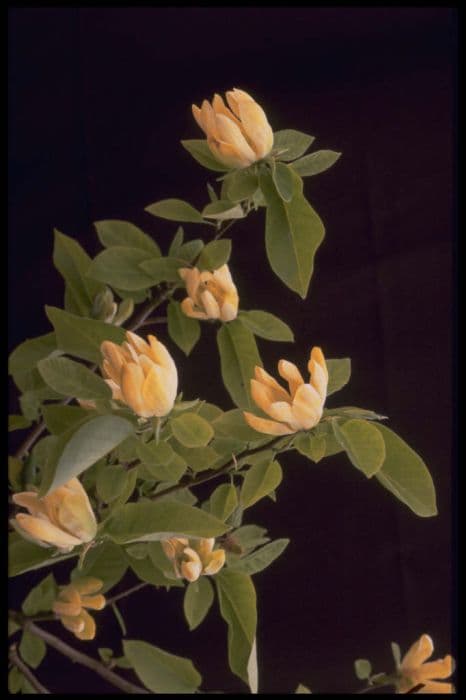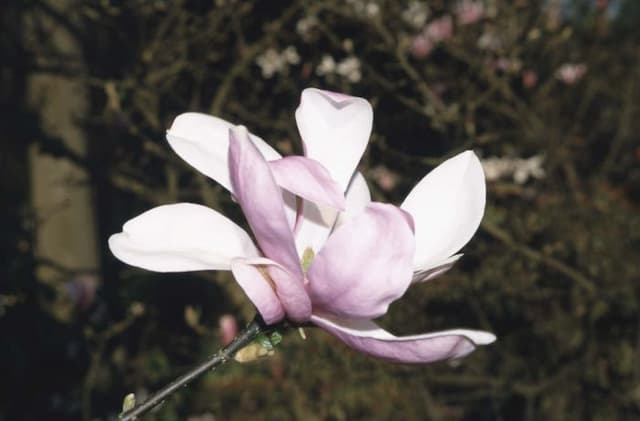Saucer Magnolia Magnolia 'Peter Dummer'

ABOUT
The Magnolia 'Peter Dummer' is a visually striking plant, especially known for its showy flowers. The blooms are large, with a delicate yet impressive tulip shape, exuding elegance and beauty. They typically emerge in a vibrant pink color, displaying a rich, deeper hue on the outside, while the inside reveals a lighter, almost creamy pink to white shade, often bathing the petals in a gradient of color that is truly eye-catching. The leaves of the Magnolia 'Peter Dummer' are glossy and dark green, providing a lush backdrop against which the flowers stand out. The foliage tends to be leathery in texture, elongated, and oval-shaped, with a smooth margin that outlines each leaf, creating a neat, sleek appearance. This plant tends to bloom in spring, sometimes into early summer, creating a spectacle as the individual flowers open to reveal their inner beauty. As with most magnolias, the 'Peter Dummer' also has a seed cone-like fruiting structure, which ripens in late summer to early fall. This structure, along with the plant's branches and overall form, adds to its ornamental value throughout the growing season, making it a favorite among gardeners and plant enthusiasts for its continuous display of natural charm.
About this plant
 Names
NamesFamily
Magnoliaceae
Synonyms
Peter Dummer Magnolia
Common names
Magnolia 'Peter Dummer'.
 Toxicity
ToxicityTo humans
Magnolia, specifically the Magnolia 'Peter Dummer' cultivar, is not commonly known to be toxic to humans. While not considered edible, ingestion of plant parts such as leaves or flowers does not typically lead to poisoning or serious health risks for most people. If large quantities are consumed, it may cause mild stomach upset, but this is rare. Always exercise caution and keep plant parts away from young children who might ingest them out of curiosity.
To pets
Magnolia, including the Magnolia 'Peter Dummer' variety, is generally considered to be non-toxic to pets such as dogs and cats. Although it is not known for being poisonous, it is still advisable to prevent pets from ingesting the plant. If a pet were to eat parts of a Magnolia, they might experience mild gastrointestinal upset including vomiting or diarrhea due to the unusual material in their digestive system, but serious toxicity is unlikely.
 Characteristics
CharacteristicsLife cycle
Perennials
Foliage type
Deciduous
Color of leaves
Green
Flower color
Pink
Height
20 feet [6 meters]
Spread
15 feet [4.5 meters]
Plant type
Tree
Hardiness zones
7
Native area
Cultivar
Benefits
 General Benefits
General Benefits- Aesthetic Appeal: The Magnolia 'Peter Dummer' produces large, fragrant, pink-purple flowers that add stunning visual interest to any garden space.
- Year-Round Interest: With its evergreen leaves, the Magnolia 'Peter Dummer' provides greenery throughout the year, even in winter months.
- Wildlife Habitat: The tree offers shelter and food for birds and other wildlife, with its dense foliage and large flowers being particularly attractive to pollinators like bees.
- Low Maintenance: Once established, the Magnolia 'Peter Dummer' requires minimal care, making it ideal for both experienced and novice gardeners.
- Shade Provision: Its leafy branches create a pleasant shade, making it a good choice for planting in sunny areas where shade is desired.
- Windbreak: The dense growth of the Magnolia 'Peter Dummer' can act as a windbreak, protecting gardens and homes from strong winds.
- Privacy Screening: Tall and dense, this magnolia can be used for privacy screening to block unwanted views or to create a natural border.
 Medical Properties
Medical PropertiesThis plant is not used for medical purposes.
 Air-purifying Qualities
Air-purifying QualitiesThis plant is not specifically known for air purifying qualities.
 Other Uses
Other Uses- The wood of Magnolia can be used in furniture making, providing an elegant and durable option for indoor furnishings.
- Magnolia flowers can be crystallized and used as edible decorations for cakes and desserts, adding a unique florals touch.
- The bark of some Magnolia species can be processed into a fabric dye, offering a natural coloring agent for textiles.
- Magnolia seed pods can be used in floral arrangements or as part of decorative wreaths for a rustic aesthetic.
- The leaves of Magnolia can be utilized in the professional floristry industry as a long-lasting greenery option in bouquets and arrangements.
- Dried Magnolia petals can serve as an organic and fragrant component of potpourri blends for home fragrance.
- Magnolia trees can be planted in urban landscapes to help reduce noise pollution due to their dense foliage.
- Magnolia blossoms can be used in the production of handcrafted natural perfumes, providing a subtle fragrance base.
- Magnolia cones and seeds can be transformed into unique pieces of jewelry, like necklaces and earrings, through creative crafting techniques.
- The large, sturdy leaves of Magnolia can be used in art projects, such as leaf painting or printing, as they can hold a variety of pigments and patterns.
Interesting Facts
 Feng Shui
Feng ShuiThe Magnolia tree is not used in Feng Shui practice.
 Zodiac Sign Compitability
Zodiac Sign CompitabilityThe Magnolia tree is not used in astrology practice.
 Plant Symbolism
Plant Symbolism- Perseverance: Magnolias are known for their ability to survive harsh climates and they often symbolize endurance and long-standing tenacity.
- Nobility: With their large, impressive blossoms, magnolias are often associated with a sense of dignity and grandeur.
- Feminine beauty: The elegant and delicate appearance of the magnolia flower is commonly linked to the purity and softness of feminine beauty.
- Purity: The pristine white flowers of some magnolia varieties are symbolic of purity and innocence.
- Love of nature: As magnolias are ancient plants with a long history, they are often connected to a deep appreciation for the natural world.
 Water
WaterThe Magnolia 'Peter Dummer', commonly referred to as the Peter Dummer Magnolia, should be watered deeply to ensure the soil is moist but not waterlogged, particularly during the first few seasons to establish a good root system. On average, this may mean watering with about 1-2 gallons per week, depending on climate and soil conditions. During the growing season, especially in dry spells without rainfall, the amount may need to be increased. Reduce frequency in winter when the plant is dormant. Always check soil moisture before watering; soil should be allowed to dry slightly between watering sessions.
 Light
LightThe Peter Dummer Magnolia thrives in full sun to partial shade. A spot that receives morning sunlight and some afternoon shade is ideal, ensuring the plant gets at least four hours of direct, unfiltered sunlight daily. Avoid deep shade locations as this can impact its blooming and overall health.
 Temperature
TemperatureThe Peter Dummer Magnolia does well in a temperate climate with ideal temperatures ranging between 70-85°F during its active growth period. It is capable of withstanding brief cold dips down to about 20°F but should be protected from prolonged exposure to temperatures below this threshold. For optimal health and blooming, avoid extreme temperature fluctuations.
 Pruning
PruningPrune the Peter Dummer Magnolia to maintain its shape, remove any dead or broken branches, and promote healthy growth. The best time for pruning is after flowering, in late spring or early summer, to avoid cutting off next year's buds. Pruning every 2 to 3 years or as needed is generally sufficient for healthy maintenance.
 Cleaning
CleaningAs needed
 Soil
SoilMagnolia 'Peter Dummer', more commonly known as Saucer Magnolia, thrives best in a soil mix that is well-draining, rich in organic matter, with a slightly acidic to neutral pH of 5.5 to 7.0. A blend of loamy garden soil, compost, and perlite or pine bark can provide the proper texture and fertility.
 Repotting
RepottingSaucer Magnolias, which include 'Peter Dummer', are slow-growing trees and do not require frequent repotting. They should be repotted when they outgrow their current pot or every 3 to 5 years to refresh the soil.
 Humidity & Misting
Humidity & MistingSaucer Magnolia, including the 'Peter Dummer' cultivar, prefers moderate humidity levels. It can tolerate normal outdoor humidity but should not be subjected to excessively dry or extremely humid conditions for optimal growth.
 Suitable locations
Suitable locationsIndoor
Ensure bright light, well-drained soil, and room to grow.
Outdoor
Plant in moist, acidic soil in partial-full sun.
Hardiness zone
4-9 USDA
 Life cycle
Life cycleThe life of a Magnolia 'Peter Dummer' starts as a dormant seed which, when provided with the suitable conditions of warmth and moisture, will germinate and sprout. It then grows into a young seedling, exhibiting initial leaves that will develop into a more complex leaf structure as it matures. As the plant continues to mature, it will enter the vegetative stage, producing lush foliage and establishing a sturdy root system. After some years, depending on growing conditions, Magnolia 'Peter Dummer' reaches maturity and will start its reproductive phase, which involves the blossoming of large, fragrant flowers, typically in the springtime. Following pollination, typically by bees or beetles, the flowers will give way to cone-like fruit aggregates that contain the seeds. Upon reaching the end of its lifespan, which can be many decades if the tree is healthy and in favorable conditions, the plant will gradually decline and complete its life cycle.
 Propogation
PropogationPropogation time
Spring-Early Summer
The most popular method of propagation for the Magnolia 'Peter Dummer' is through semi-hardwood cuttings. This process typically takes place during the summer months when the plant is actively growing. To propagate by this method, a cutting of about 4 to 6 inches (10 to 15 centimeters) long is taken from a healthy branch, ensuring it has at least two sets of leaves. The bottom set of leaves is removed, and the cut end is dipped in rooting hormone to encourage root development. The cutting is then planted in a moist potting mix, with the leaf node—where the removed leaves were—buried just below the soil surface. The pot is placed in a warm area with indirect light, and the soil must be kept consistently moist but not waterlogged. With proper care, roots will develop within a few weeks, after which the new Magnolia 'Peter Dummer' can eventually be transplanted outdoors.

![Magnolia [Fairy Blush]](/_next/image?url=https%3A%2F%2Fplants-admin.emdemapps.com%2Fimages%2Fplants%2F%2Fimages%2F604b5a108e959.png&w=640&q=75)







![Magnolia [Black Tulip]](/_next/image?url=https%3A%2F%2Fplants-admin.emdemapps.com%2Fimages%2Fplants%2F%2Fimages%2F604b590290fc7.png&w=640&q=75)